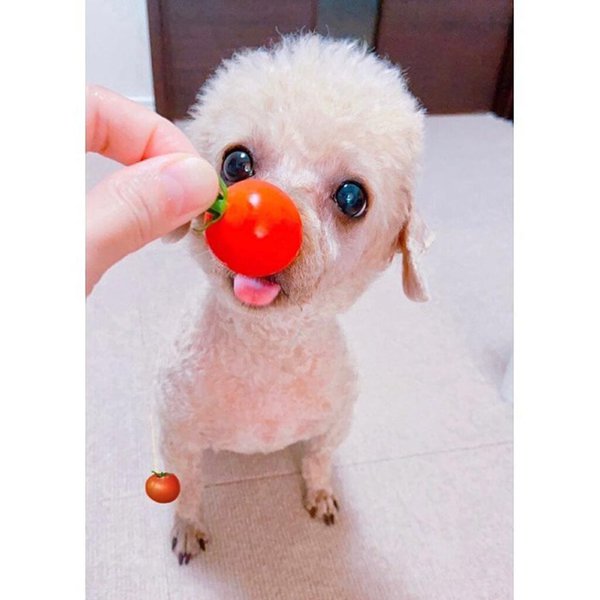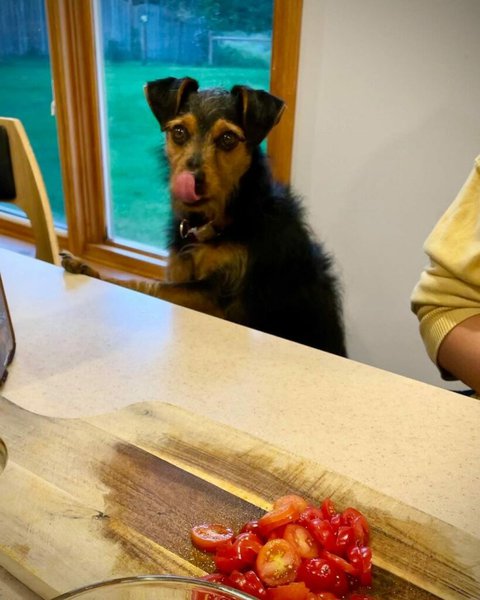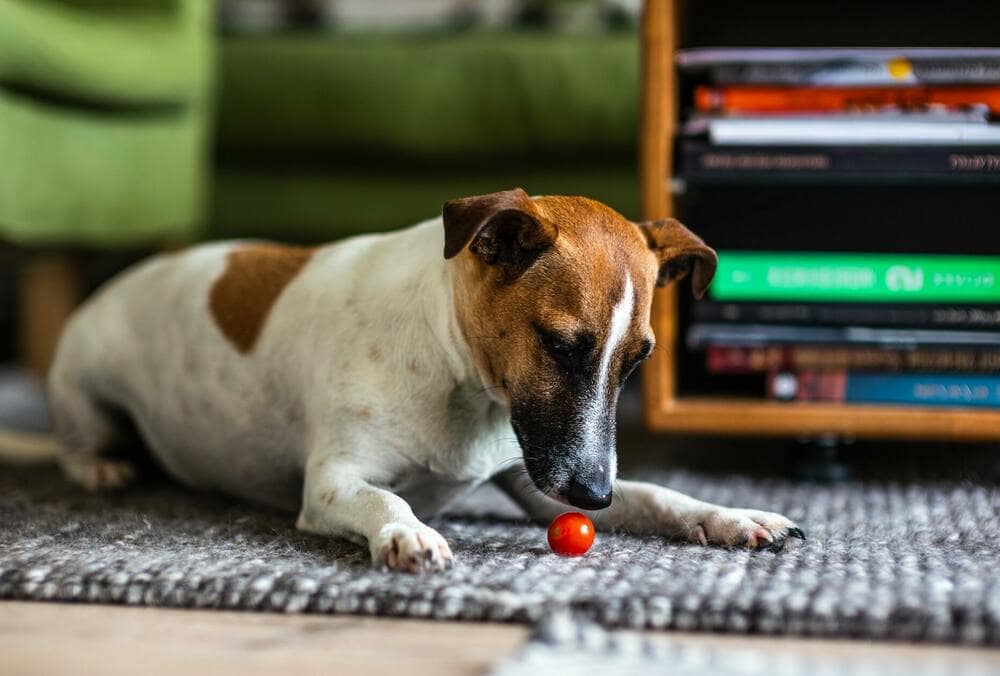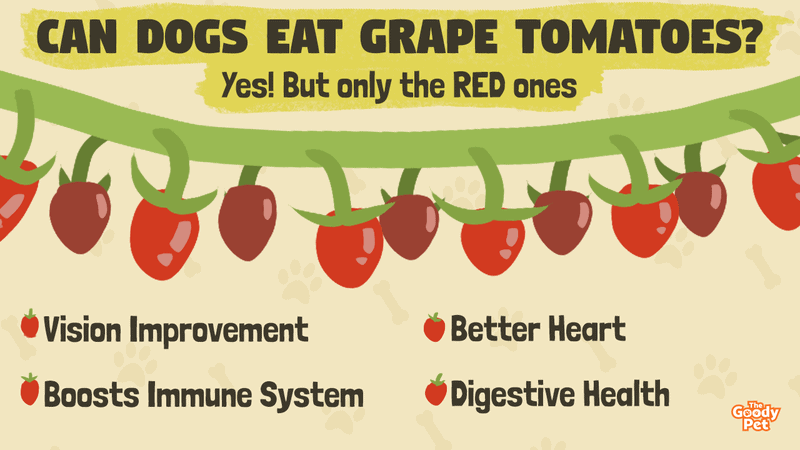We all know that grape tomatoes are not just vegetables or fruits but something more. They are often served as a healthy snack food, so we tend to grow them in our home gardens. Since grape tomatoes are easily available in our homes, our furry fidos can often be seen attempting to get some to eat. This is why dog owners are concerned about whether their dogs can safely eat grape tomatoes.
Dogs can safely eat grape tomatoes only when the grape tomatoes are well ripe and red in color. It’s all about the condition of grape tomatoes! The unripe and green grape tomatoes can actually make your dog sick. This is primarily due to the toxicity from solanine chemical compounds, among many factors.
As both we and our little buddies love having these grape tomatoes, we will cover a list of benefits this snack gives our fidos in this article. Serving ideas, do’s and don’ts will also be mentioned for the readers. Other things we will talk about in detail include, to what extent the grape tomatoes can damage our pooch’s internal system, the amount for safe consumption levels, the signs of tomato poisoning, and details about allergies.
Before we dive deep into these things, first let’s understand how an unripe green grape tomato is poisonous whereas its ripe red counterpart is totally safe to our pooch.
Are Grape Tomatoes Poisonous To Dogs?
The red ripe grape tomatoes are good and healthy for dogs if they are being served occasionally as treats. The unripe green grape tomatoes, however, are known to be poisonous and should never be fed to our pooches.
It will be fine as long as the grape tomatoes your canine buddy eats are red in color. This is because the green color in the case of grape tomatoes is a sign of danger. Whether it is a green stem, green leaves, or a tomato in an immature form, gulping them down leads to severe illness and serious disturbances inside your pooch’s stomach.

Toxicity Behind Green Tomatoes
Tomato plants, including grape tomatoes, belong to Solanaceae or the deadly nightshade family, one of the most poisonous plant families known. Grape tomatoes should never be confused with fruits of the Vitis family, which are also toxic to dogs.
The tomatoes we eat will develop and carry two toxic chemical compounds, namely Solanum glycoalkaloid and alpha-Tomatine. These two chemicals can be found in almost all the green parts of the tomato plant, including leaves, stems, and the unripe grape tomato pieces.
Well, the leaves and stem parts remain toxic eternally. However, when it comes to green unripe tomatoes, the toxic chemicals tend to disappear when the fruit starts turning into a ripe piece and developing a red hue.
To reiterate, red grape tomatoes are, in fact, okay for canines to consume but not the green immature ones! With that being said, do remember to keep your tomato plants and all their toxic parts fenced off in your home garden to always keep them out of reach of your pooches.
Grape Tomato Allergy Symptoms
Other than this, sadly, dogs can be allergic to even red grape tomatoes too sometimes, so make sure you start with a small amount at the very beginning and do check for allergic reactions. Some of the most common allergy symptoms you will notice can be:
- Upset stomach (diarrhea, vomiting, gas and flatulence)
- Sneeze and coughs
- Itching and skin rashes
Moreover, if your buddy has already been suffering from gastrointestinal issues, obesity, and problems like acid reflux, do consult your vet before introducing your fido to this sweet snack.
Usually, fresh red ripe grape tomatoes, when provided as occasional treats, are found to be healthy and beneficial for a dog’s health, so you shouldn’t worry that much. Next, let’s look into the benefits these grape tomatoes bring.
Are Grape Tomatoes Good For Dogs?
Yes, of course, these grape tomatoes provide tons of health benefits to your canine’s body, in terms of improving vision health, boosting immune system, improving heart and digestive health and maintaining the overall health of your pooch’s coat skin.
Until now, it was all about the chances of risks we can have with grape tomatoes in this article. However, it is clearer now that our fido can eat the ripe red grape tomatoes without fear. Actually, there are so many hidden benefits behind the consumption of these ripe grape tomatoes that they genuinely become a perfect occasional treat for pooches.
Your furry buddy will improve a major part of its health with the consumption of nutrient-packed grape tomatoes. This is one of the reasons why tomato pomace is often listed as an ingredient on the label of dog food products.
So, let me introduce, in detail, the nutrients these grape tomatoes are filled with, as well as the benefits they can provide to a dog’s health.
Vision Improvement
Dogs are more prone to eye problems like cataracts and PRA and easily tend to reach the stage of blindness. Grape tomatoes can be something really beneficial to these little furry animals as they are packed with vitamin A, which helps improve eyesight.
Vitamin A also helps to boost canines’ immune system and supports all their reproductive processes as well. They also maintain your pooch’s bone health.
Beta-carotene found inside grape tomatoes is also known for improving vision as the body converts them into the same vitamin A. Beta-carotene also improves canine’s cognitive functions and is one of the elements responsible for the red prominent color.
Boosted Immune System
Fidos can get their immune system boosted with the consumption of red grape tomatoes as they are rich in carotenoid “lycopene”. The intake of lycopene provides a dog’s body a lot of other health benefits as well.
For instance, lycopene reduces the chances of different types of cancers in your pooch. It also lowers the risk of heart issues and diseases like stroke. Lycopene also makes your furry buddy’s bones stronger while maintaining their good bone health.
Lastly, since lycopene is an antioxidant, it helps to remove the free radical molecules from your pooch’s body that are meant to damage body cells inside.
Grape tomatoes are entirely full of lycopene though; however, as this carotenoid is also known for providing the bright red color to the tomatoes, the skin part carries most of the amount.
According to a study published by Fielding JM back in 2005, cooked grape tomatoes carry more lycopene than what the fresh tomato pieces come up with naturally. This shows that introducing fidos to processed grape tomatoes is definitely a good idea.
Still, there are a number of exceptions to keep in mind.
- Cook red-colored ripe grape tomatoes only.
- Try getting fresh and organic pieces, as they are not sprayed with pesticides.
- Wash them well before cooking.
- Always serve your pooch cooked grape tomatoes that are completely pure. Never make the mistake of adding flavors or additives like salt, sugar, garlic, or onion, as they can be really harmful to your furry buddy.
- Prefer cooking at home rather than getting processed products from the market.

Better Heart And Digestive Health
When consumed on an occasional basis, grape tomatoes can actually improve the heart health of canines, as well as their digestive health. This is possible because grape tomatoes are rich in potassium and soluble fibers.
Potassium found in grape tomatoes helps with the regulation of fluid levels in the bodies of canine. This includes sugar level, cholesterol level, and blood pressure level. In addition, potassium aids in better blood circulation and is vital for muscle contraction.
On the other hand, soluble fibers found in grape tomatoes, when consumed, help regulate a pooch’s bowel movements and the blood sugar levels inside the body by slowing down digestion, which is good for dogs with diabetic problems. It also makes your fido feel full for a long time after meals, thereby reducing overall food intake and risk of obesity issues.
Healthy Coat Skin
The final benefit grape tomatoes can offer is a healthy coat skin that keeps a dog looking fresh as always. They are rich in vitamin C, which we all know is really good for the skin.
Vitamin C is an antioxidant as it neutralizes the free radical molecules that cause oxidative stress and provide damage to the body cells. It is also good for bone health, since it takes part in body functions like collagen formation. It is also believed to boost your furry buddy’s immune system.
Here is a great tip for helping your pooch to achieve a healthy coat skin. Whenever your dog burns some extra energy or faces anxiety, the synthesis of vitamin C inside the body gets interrupted.
If this happens, try serving your canine buddy with grape tomato treats. These treats will definitely reduce your pooch’s anxiety and make it feel better. However, do remember, the grape tomatoes must be red and ripe because green ones are toxic to your pooch.
How Much Tomato Is Toxic To Dogs?
Green tomatoes provided in small amounts can upset canines’ stomachs but cannot be usually toxic to them. These green parts or solanine chemical compounds are toxic to your fido only when ingested in large amounts.
Toxicity basically depends on the amount of solanine present inside a tomato which is really high in green or unripe grape tomatoes as compared to the red ones. Red tomatoes barely contain solanine, so they are totally fine for your pooch.
Still, many of you have been wondering exactly how much tomato is believed to cause toxicity or how much can be declared as a safe amount.
Toxic Dose Levels To Reach Tomato Poisoning
In the list below, I have explained this all with the help of some interesting facts about tomatoes and some quick calculations.
- A medium-sized unripe tomato contains 55 mg of solanine.
- A medium-sized ripe tomato contains 0.5 mg of solanine.
- It is believed that only 25 mg solanine is enough to disturb one’s internal system.
In other words, a dog needs to intake half a green tomato to face tomato poisoning and reach a toxic level. Pieces smaller than that will not ideally harm your pooch, however, can lead to diarrhea and vomiting.
Still, always remember that the stomachs of little puppies are comparatively more sensitive than the adult ones, and even one tiny piece can do some harm to them. It is best to visit the vet in these cases, even if your pooch consumes a very small amount.
In the case of red tomatoes, they are perfectly fine. According to the facts mentioned above, a canine’s stomach will find disturbance only after consuming around 50 red grape tomatoes, a number which we all know is more than enough.

Ideal Serving Size For Ripe Red Grape Tomatoes
You should ideally serve a treat of 1 to 2 pieces every other or two days. However, this serving size should be closely monitored, as grape tomatoes are not part of a dog’s regular diet.
Tomato poisoning rarely happens to dogs, as tiny pieces of unripe tomatoes do not generally harm dogs, so you don’t have to worry about it. The only concern is that you will often remain unaware of the amount your furry buddy has gulped down in your absence and you will not be able to determine whether your pooch is totally fine or in pain thereafter.
Hence, should you ever find her near green grape tomatoes or hanging out in your home garden, always keep a constant, close eye on your canine buddy. When you do find out that your pooch has eaten some green grape tomatoes, make an immediate trip to the vet, regardless of the amount your pooch has ingested.
In addition, always ensure to keep these green grape tomatoes out of reach. Consider setting up an enclosure around your home garden or trap doors to keep your pooch out of the garden premises.
Signs Of Tomato Poisoning
To conclude, here are the signs of tomato poisoning you should be aware of, in an event that your pooch happens to have consumed grape tomatoes on exceedingly high levels. Understanding this can help save your pooch’s life if it is brought to the vet for treatment upon early detection of these warning signs.
- Digestive or gastrointestinal issues, i.e. vomiting and diarrhea
- Excessive drooling, also called hypersalivation
- Dilated eye pupils
- Drowsiness and lethargy
- Weakness in muscles and tremors
- Rapid heartbeat
- Loss of appetite
- Uncertainty or confusion
- Loss of coordination





